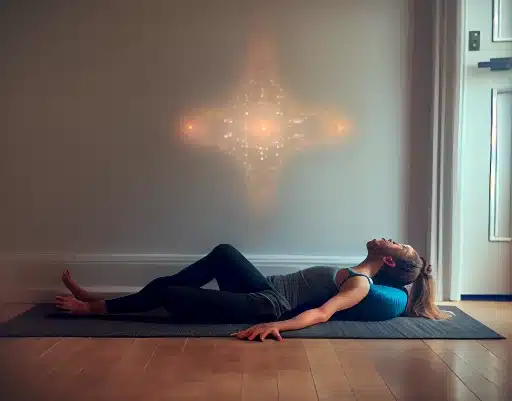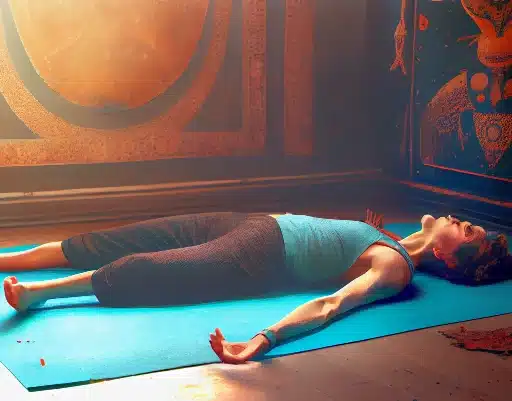Yoga Nidra, an ancient form of meditation that has been around for centuries, is a powerful technique known for inducing deep relaxation and peace. In recent times, it has become increasingly popular as people have discovered its ability to help them find inner calm, clarity and rest.
In this blog article, we will dive into the many benefits of Yoga Nidra, how to practice it and how it can be used as a sleep meditation. Additionally, we will also examine the differences between Yoga Nidra and traditional meditation, any potential side effects and highlight the top 7 benefits of Yoga Nidra.
You can also try this 5-minute body scan guided meditate instead of long yoga nidra session.

Unleash Your True Potential!
Explore the world of meditation with our powerful guided sessions crafted to bring peace and strength to your spirit.
But first, let’s ensure our sessions are the perfect fit for you.
Take our short quiz to find out!
Table of contents
- What is Yoga Nidra?
- Yoga Nidra Meditation Techniques
- Yoga Nidra for Beginners
- Yoga Nidra vs. Meditation
- 7 Benefits of Yoga Nidra Meditations
- What Research And Studies Are Saying About The Yoga Nidra Benefits?
- Steps Practice Yoga Nidra Meditation
- Yoga Nidra Side Effects
- Can I Practice Yoga Nidra In Bed Before Going To Sleep?
- How many hours of sleep is one session of yoga nidra practice?
- Conclusion
What is Yoga Nidra?
Yoga Nidra, also popularly known as “yogic sleep”, is a meditative technique that promotes deep relaxation and heightened awareness. It is an effective method for calming the mind and body, and attaining a sense of inner peace and clarity. This practice has been utilized in traditional yoga for centuries.

During Yoga Nidra, the practitioner is lead into a state of deep relaxation and meditation. The purpose of this is to reach a place of tranquility and silence, where the mind can let go of thoughts and emotions. The body becomes relaxed and breath is slow and gentle. The practitioner is then guided through mental images, visualizations and affirmations, that assist in reaching a state of deep relaxation and inner peace.
Yoga Nidra Meditation Techniques
All the yoga nidra sessions are more so the same, something that changes is the technique of relaxation used by the yoga teachers.
Yoga nidra is often practiced with the help of a guru or a certified yoga teacher can also teach yoga nidra to you. Even thought it’s better to learn from the experts, a guided meditation or yoga nidra can also be a great option. The “Yogic Sleep” after all is a meditation technique and if you are familiar with yogic practice, it will be easy to do.
Which ever way you chose to practice yoga nidra, you will be guided through a chain of mental images and visualizations. The only thing you want to concentrate on is relaxing in a comfortable position. Mostly yoga nidra practice is in done in corpse pose, which basically means lying down straight like a corpse.

The practitioner is then guided through a series of mental images and visualizations. These can include imagining a peaceful place, such as a beach or a mountain, or a positive affirmation, such as “I am peaceful and relaxed.” During this part of the practice, the practitioner is encouraged to stay present and focus on their breath.
Then you will be guided through a series of body scans, in which you will focus on different parts of the body and mentally scan for any areas of tension or discomfort. This is going to help you become more aware of your body and to begin to relax and release any tension or stress in the body.
You will continue to stay in this relaxed sleep like state for as long as you want or as long as the yoga nidra session is determined by the on teaching you.
What if you fall asleep during Yoga Nidra session?
If you are using a guided meditation then falling asleep is okay. You can simply roll over in a comfortable sleeping positions and enjoy deep rest. It will imenesly improve your sleep quality and sleep efficiency.

In case you are not using guided meditation or doing yoga nidra practice at a time when you don’t want to fall asleep. In the end, you will be guided back to your natural state of awareness. focusing on your body and breath awareness. This part of the practice helps to become more present and aware of you body and deep rest, peace and calm.
Yoga Nidra for Beginners
Yoga nidra is a great for beginners because it’s simple to do and allows you to rest well. It is a very gentle practice that can be done in comfort of your own home. Especially today when we have easy access to meditation apps that reduce so much effort from the aspect of learning. Enhanced meditation app especially has a multitude of meditation techniques.
If you are a beginner, it’s a great way to learn the basics of meditation and to begin to explore the power of relaxation and stillness.
The key to success with yoga nidra is to find the right teacher or guide. A good teacher or guide will be able to provide support and guidance as you explore the practice. They can also provide advice and tips on how to get the best from the practice.
Yoga Nidra vs. Meditation
Yoga Nidra and Meditation are both powerful tools for achieving inner peace and relaxation, but they approach it in different ways. Meditation is a practice that focuses the mind on one particular object, idea or thought, which is intended to foster mindfulness and increase presence in the present moment. On the other hand, Yoga Nidra practice is centered on deep relaxation and heightened awareness. Through a series of guided meditations, mental images, and visualizations, Yoga Nidra aims to relax both the mind and body, creating a sense of inner peace and clarity.

Meditation requires a certain level of discipline, focus and attention to achieve the intended goal. It could be as simple as following one’s breath or more complex such as Vipassana meditation which involves deep introspection and self-reflection. While Yoga Nidra is more passive, it is still a very effective method of relaxation. It is accessible to people with different levels of meditation experience, even beginners. It is often described as “sleep with awareness” as the practitioners are led into a state of deep relaxation, but are still conscious and aware.
Both Meditation and Yoga Nidra are great practices to include in a daily routine to improve the well being and overall quality of life. While Meditation allows one to develop mindfulness and focus, Yoga Nidra induces deep relaxation and rejuvenation for both body and mind. They are different tools with different focuses but both are powerful in their own way.
So, we can say that yoga nidra doesn’t fit into the traditional forms of meditation but we can still think of it as meditation.
Related: 5 Ways Evening Meditations Change How Your Mind Works
7 Benefits of Yoga Nidra Meditations
Yoga Nidra offers many benefits for both the body and your mind. It can greatly help to reduce stress and anxiety, emotional balance, and mental clarity. It also has physical benefits, such as increased energy, faster recovery post work out, improved blood circulation, and better sleep.
Let’s look at the benefits of practicing yoga nidra in detail.
1. Significantly reduces stress and anxiety:
Yoga nidra is an incredibly effective practice for reducing stress and anxiety. It can help to relax the body and mind and to cultivate a sense of peace and calm.
2. Can elevate mood and promote emotional well being:
Yoga nidra is a great way to promote emotional wellbeing. It can help to reduce depression and anxiety and to cultivate a positive outlook on life.
3. Yoga Nidra can increase mental clarity:
Yoga nidra can help to improve mental clarity and focus. It can help to reduce mental fog and to increase productivity and creativity.
4. Improves the quality of sleep:
Yoga nidra can help to improve the quality of sleep. It can help to reduce insomnia and to promote a deeper, more restful sleep.
5. Enhances physical well-being and health:
You sleep better, you body recovers better. Yoga Nidra can significantly help to improve physical health. It can help to reduce physical tension and to increase circulation and energy.
6. Self-awareness:
Yoga nidra is a great tool for self-exploration. So, it can help to cultivate a deeper understanding of oneself and to gain insight into one’s thoughts and emotions.
7. Allow deeper spiritual connection with yourself:
Yoga nidra can help to develop a deeper connection with the self and the world around us. It can help to cultivate a sense of peace and connectedness.
What Research And Studies Are Saying About The Yoga Nidra Benefits?
Reduction in stress, worry, and depression
A study called iRest from 2013 looked at whether Yoga Nidra practice, a form of yoga, was associated with reduced perceived stress, depression, and worry and increased mindfulness in college students.
The research included 66 students who completed an 8-week Yoga Nidra intervention and assessments were taken before and after the intervention. The study found statistically significant improvements in perceived stress, worry, and depression, and improvements in mindfulness-based skills. The study concluded that Yoga Nidra practice may be effective in reducing symptoms of perceived stress, worry, and depression and increasing mindfulness-based skills in college students.
You can also try different types of guided meditation to help with stress and anxiety.

Unleash Your True Potential!
Explore the world of meditation with our powerful guided sessions crafted to bring peace and strength to your spirit.
But first, let’s ensure our sessions are the perfect fit for you.
Take our short quiz to find out!
Yoga Nidra makes our hearts work better
Another study from 2012 looked at the effects of Yoga Nidra relaxation on heart rate variability (HRV) and how it is affected by a prior bout of Hatha Yoga. They had 20 people do two different types of yoga, one type called Yoga Nidra and another type called Hatha Yoga. Researchers wanted to see if doing one type of yoga before the other changed the way our hearts work. They found that both types of yoga made our hearts work better, but it didn’t matter if you did one type before the other. It just helped our hearts work better overall.
Helps With PTSD Symptoms
This study from 2011 investigated the effectiveness of Integrative Restoration (iRest) Yoga nidra, in helping with post-traumatic stress disorder (PTSD). The study was conducted with male combat veterans, all of them had been diagnosed with PTSD. The veterans reported feeling less angry, anxious and emotionally reactive, and more relaxed, peaceful, self-aware, and self-confident after participating in the iRest classes.
Even though they faced challenges related to mental focus and intrusive memories of the trauma, they still found the classes beneficial. Furthermore, all participants reported that they would have liked to attend the classes regularly (once a week).
Steps Practice Yoga Nidra Meditation
Now you know that Yoga nidra is equally as effective as other forms of meditation if not more. It’s time to understand the steps of this amazing practice of yoga nidra. If not practiced properly, you can experience some side effects. Also, it’s good to know what to expect before you get into practicing yoga nidra by yourself or with the help of guided meditations.
5 Step Yoga Nidra Guide
- Find a safe and quiet place: It’s best to practice this meditation where you are free to doze off. Falling asleep is inevitable when it comes to yoga nidra, using a guided yoga nidra meditation is good option if you wish to meditate at home. Yoga studio practice with certified yoga teachers is also a good option.
- Set your intention: Intentions setting is not always prioritized, so some instructors will guide you to set intentions and some might not. You can always set an intention on your own, just take a deep breath and think about why you are going into this meditation.
- Get in the yoga nidra pose: Every goya instructor will describe Shavasana or corpse pose slightly different. Some advice to keep your palms up towards the ceiling and some advice to keep the palms down, facing the earth. So, do your corpse pose in a way that’s most comfortable for you.
- Pay attention to your breath and center yourself: You can start forcing on your breath and centering yourself while you wait for the instruction. You can also close your eyes if you want to.
- Following the guided instructions: You will be smoothly guided into different imageries and visualizations. You might not be able to see vivid visions initially. Don’t worry if you are not able to clearly visualize, you can easily practice and learn visualization over time.
If you find that your mind starts to wander during the meditation process and you lose track of visualization, remember to not judge yourself. It can happen, just continue to focus on the instructions and relaxation.
Yoga Nidra Side Effects
Yoga Nidra is normally safe for most people to try. However, like any form of meditation, there can be some side effects that you may experience.
Here are the few possible side effects of yoga nidra:

Dizzy or lightheaded: Some might feel dizzy or lightheaded during or after the yoga nidra session. This can happen due to the rapid changes in blood pressure when going from a seated to a lying down position.
Feeling nauseous: A lot of people can feel a bit nauseous during or after doing yoga nidra. This can happen because of the deep state of relaxation that the body experiences.
Difficulty relaxing: Some people may find it hard to relax during the process of yoga nidra. This could be the case because of mental, emotionla or physical tensions, or even lack of sleep.
Discomfort: Some people may find it uncomfortable to lie down for an extended period of time, or may find corpse yoga postures uncomfortable.
Listen to your body & if you feel any of these side effects, it’s best to take a break from meditating. You can always come back to meditate later. It’s also extremely important to practice Yoga Nidra in a place where feel safe and comfortable.
Can I Practice Yoga Nidra In Bed Before Going To Sleep?
Yoga nidra can be used as a sleep meditation. It is a great way to wind down and prepare for a good night’s sleep. It can help reduce a lot of stress and anxiety and Yoga Nidra offers deeper, more restful sleep.
The practice of Yoga Nidra can help to reduce the body’s stress response and promote a sense of calm and relaxation. It can also help to clear the mind, which is something we all struggle with when going to sleep. Additionally, it can help to reduce insomnia and improve the quality of sleep. So insomnia patients can benefit a lot from trying this yogic sleep practice before bed.

How many hours of sleep is one session of yoga nidra practice?
You want the honest answer or an idea that can comfort you for not sleeping enough?
When you are extremely tired and in need of sleep, yoga nidra practice can do a lot more than a nap would do for you. A 30 minute yoga nidra session will feel like 4 hours of sleep.
It will feel like it can substitute for the need of sleep but yoga nidra is not a sleep subtitue. However, regular practice of yoga nidra meditation can improve sleep to a tremendous extent. Because of the quality of sleep you get after regularly practicing yoga nidra you may see a reduction in the hours of sleep you need. So yoga nidra does have an impact on sleep deficit but not the way you may have thought.
Conclusion
Yoga Nidra, an ancient meditation technique, has been used for centuries to find inner peace and calmness. It can help in reducing stress, anxiety, promoting relaxation and increasing mental clarity. It is also a powerful tool for self-exploration, connecting with oneself and the world around. However, now things are changing, looking even better and we are getting to see research backed evidence, not just claims.
If you’re looking for a practice to help you relax, calm your mind and find inner peace, Yoga Nidra is a great choice. It is simple and gentle, and can be done in the comfort of your home. You can also find guided yoga nidra meditations on the Enhanced Meditation app. With regular practice, you will soon experience the benefits of Yoga Nidra Meditation by yourself.










